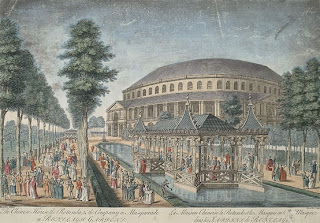Isabella reporting,
During my last few visits to
Colonial Williamsburg, I've been intrigued by one of the on-going trade studies by the staff of the Margaret Hunter shop. Mantua-maker Janea Whitacre and her apprentice Sarah Woodyard,
above, have been researching and recreating the fringe trimming that accented 18th c. gowns and accessories. Trimming was not only an important addition to a lady's gown – the final touch that elevated a gown to the next level of fashion – but fringe-making itself was also one of the specialized trades of the 18th c. luxury-clothing industry, like embroiderers and
button-makers, that thrived on the details.
Floss fringe is deceptively simple: a long woven, braided, or knotted base strand of silk, punctuated by tiny cross-elements of knotted silk floss arranged at regular intervals into the base. (Floss fringe is also known as fly-fringe, its 20th c. name, and French fringe, because even 250 years ago, anything named "French" had a more fashionable ring to it.)
Here, here, and
here are examples of 18th c. gowns trimmed with floss fringe, all from our
Pinterest boards.
In London and in Paris, fringe-makers were generally their own trade, known as the French Trimming trade, or the Narrow Fancy Trimming Branch of the Silk Manufacturer. However, fringe might also have been made by a mantua-maker (dressmaker) or milliner, and sold at millineries, which meant that fringe-making could be considered a branch of the millinery trade, too.
Fringe designs were limited only by the maker's imagination, and examples exist in scores of colors and variations. Fringe was sold wrapped on a card in 12-yard lengths, the average amount used to trim a gown. An expert fringe-maker could produce around 10 yards a day, depending on the fringe's complexity. The price would vary, again depending on the fringe. In her album,
Barbara Johnson notes that she paid five shillings for a 12-yard card.
It's safe to say that the fringe-maker herself did not earn that much, nor would she likely have owned a gown trimmed with the silk fringe she made, either. Floss fringe was used only on the costly gowns that would have been the designer dresses of their day. A fashionable silk gown in 1770s London could have cost anywhere from eight pounds sterling to over twenty-five for a ball gown worn by a peeress. To put this in sobering perspective, the mantua-maker who cut and fit that silk gown would have received two-and-a-half shillings for her twelve-hour workday, while the common seamstress who stitched the gown together would have received only one-and-a-half shillings.
In learning the 18th c. techniques, Sarah has been replicating fringe using a box loom to weave a tape-ribbon-style of fringe, by knotting the fringes into the cord, and by tying directly onto a ribbon base,
middle right. She's found she can make about ten of the little floss-fringes (
lower left; including brushing out the ends of the floss with a boar-bristle brush) in 30 minutes, and then make about 20" of finished fringe in an hour. She's currently making sufficient fringe in pale green silk floss to trim a gown made from the rose-pink silk cloth beneath it. I'm looking forward to seeing it completed the next time I visit.













































 One of us --
One of us -- 


